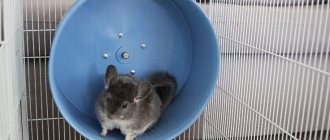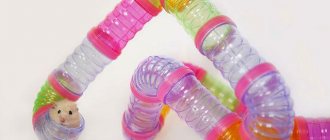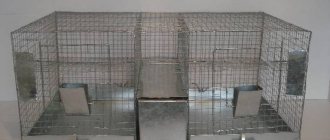It has long been noted that the hamster's favorite toy is the running wheel. Little furry needs it not only as entertainment, but also as a universal exercise machine for maintaining muscle tone. A running wheel for a hamster is bought in specialized stores for animals. But it happens that you come to the store and your eyes widen - that’s how many hamster rides there are! We will tell you how to choose the best toy for your pet that matches its breed and size.
Why do hamsters love running on wheels?
Once in captivity, the hamster no longer needs to worry about food, and its living space becomes limited.
A walking option with such a pet is not suitable, because the animal is small and is hunted by a large number of animals: domestic and wild. And if you do not provide him with additional physical activity, then the rodent will develop health problems: obesity, disruptions in the cardiovascular system, slower metabolism, and decreased muscle tone.
In addition, without entertainment, the animal falls into the blues, becomes lethargic and sad.
Why do they need a wheel?
It's no secret that hamsters themselves are very active and mobile animals. They almost always run – it’s unrealistic to see them crawling slowly. Why is that? It's all about instincts. Naturally, this is not a predator, because the hamster does not have powerful fangs, sharp claws or strong muscles. All they can do to protect themselves is speed.
Hamsters love to run and this is developed at the level of instincts
Do-it-yourself silent hamster wheel, on bearings.
Hamsters are known to be nocturnal rodents. It is at this time of day that they emerge from their burrows in search of food. Even though they eat little, they still need a lot of food - simply because they constantly hide it in reserve. The funny animal spends almost all its “free” time searching for food.
Such an event threatens hamsters with serious trouble. The fact is that at the same time classic nocturnal predators, for example, owls, appear. A rodent must be able to protect itself from them, especially from fast-flying birds. And high-speed travel is the best solution for this.
All this leads to the fact that the hamster is a hardy animal, capable of generating huge amounts of energy. Even if he lives in captivity, his instincts do not go away. It is at night that the pet tries to get rid of the energy accumulated during the day. And the best option for this is a wheel installed in a cage. This is as important an attribute for a hamster as perches are for parrots.
Varieties of homemade exercise equipment for hamsters
When making a hamster simulator, you need to immediately think through all the options: determine the dimensions, installation, choose the material. It should be comfortable for the pet and not injure it when running.
By diameter
You should choose the diameter of the circle, paying attention to the dimensions of the animal.
A drum that is too tight creates inconvenience for the hamster, because when running it has to bend strongly, which leads to curvature of the spine.
But if the animal is too wide, it will be difficult for him to spin, and he will soon abandon such an attraction.
According to manufacturing materials
A running wheel for your pet can be assembled from scrap materials. Wood, cardboard, plastic or a tin can are most often used. Since a hamster is a rodent, the design should not contain toxic substances: paint, varnish, etc.
By mounting method
Hamster wheels are attached in various ways:
- On the wall or bars of the cage. This installation saves space, but it has a negative side. During operation, the simulator touches the cage and makes noise. And since hamsters do not sleep at night, this creates inconvenience for the owners of the animal.
- To the bottom of the cage. This type of mount is unstable. The structure can turn over with the hamster.
- On a stand. The most convenient way. The simulator secured in this way produces little noise during operation and is securely mounted. However, it takes up a lot of space.
What materials are best to make it from?
You can make a wheel from many available materials:
- Tree. Wooden wheels are made from small boards. Ice cream sticks are perfect for this purpose. You will also need a rectangular wooden beam and metal wire. Such a wheel turns out to be durable and requires virtually no financial costs. But if it is not weighted down from below, then it can turn over while running, since it weighs very little.
- Tin can or disk. To make it you will need a tin can of the required size, a screwdriver, a knife for cutting metal, a glue gun, and wire. The design is also quite durable. But if the edges of the jar are not treated, the hamster may cut himself on them. In addition, this design does not look very aesthetically pleasing.
- Cardboard. This wheel is suitable for small rodents, as it is not durable. The design is very simple to make; even a child can do it under the supervision of an adult. Be sure to choose a thick cardboard so that it does not sag under the weight of the hamster.
Have you decided to make a wheel from natural materials?
Requirements for a rodent trainer
To ensure that the hamster feels comfortable and its owners do not experience inconvenience from the sound of the wheel hitting the cage, the design nuances should be comprehensively considered.
To install a successful simulator you need to:
- its diameter corresponded to the size of the animal;
- the width of the treadmill was optimal for the animal’s paws;
- the attachment of the wheel to the axle was strong and at the same time movable, it turned easily;
- the accessory did not make noise;
- The running surface was comfortable.
Which simulator to choose depending on the type of animal
When choosing the size of the product, it is worth considering the breed of hamsters. For the Djungarian hamster, it is better to choose a small wheel. Its diameter should be 14-16 cm.
The Syrian hamster will need a large trainer. Its diameter should not be less than 18 cm. It is better if it is 20-24 cm.
The width of the track also matters. For the Djungrik, the width of the device should be 5 cm, and for the Syrian - 7 cm. If the path is too narrow, the animal may fall off the simulator.
What you need to know when making a running wheel
It’s easier to buy an accessory for a pet in a store, but making a hamster wheel with your own hands is more interesting. You just need to know the parameters and choose the material.
Optimal diameter
The diameter of the simulator’s circumference must be selected individually, depending on the age and breed of the rodent.
If a Djungarian hamster (adult) requires a diameter of 14–15 cm, then for a young one 12 cm is suitable. But when the animal grows up, the accessory should be changed to a more spacious one.
The Syrian hamster needs more space - 18 cm.
Dwarf rodent breeds easily fit in a drum with a diameter of 10 cm.
Material selection
A wooden trainer is more difficult to make, but it is more durable and safer if an animal starts to chew on it. In addition, this design is quieter and looks more aesthetically pleasing.
The metal frame is also not bad, but with prolonged use it soon begins to creak. And the running surface requires additional treatment.
A cardboard structure is assembled faster, but does not last long. Thick corrugated cardboard is used for it. It is convenient for a rodent to run along its surface, clinging with its paws. Since the simulator is lightweight, it is suitable for small breeds of hamsters or young individuals.
A wooden exercise machine will last longer.
Wheel surface
The width of the running surface should also correspond to the size of the pet. For an adult, 7 cm is needed. For dwarf breeds, 5 cm is enough. If the width is made smaller, the rodent will fall from the simulator. If it is more, he will not have enough strength to spin the drum.
The inner surface is made ribbed so that when running the hamster clings to its paws. Therefore, if the cylinder is made of metal or plastic, it is covered with fleecy cloth or pasted over with wooden inserts.
The use of lattice material for the inner surface is also acceptable, but the cells should not be large so that the animal’s paws do not fall into them.
And it is necessary to ensure that there are no extra bumps or gaps on the treadmill, which could cause a fall or injury.
Types of wheels and how to choose the right one
Not only his health, but also his physical safety will depend on the successful choice of a wheel for a hamster. There are dozens of variations of running wheels for rodents, but not each of them may be suitable for a particular cage and its inhabitant. First of all, you need to pay attention to the diameter of the wheel, since it is this that determines what breed of hamster the manufacturer has prepared the simulator for. A wheel for a dzhungarik or baby Syrian breed will be from 14 to 16 cm in diameter, smaller wheels are suitable exclusively for baby dwarf rodents, and adult Syrian hamsters will require a wheel with a diameter of 18 cm or more.
The hamster wheel should be large and comfortable so as not to create obstacles or traumatic consequences. A wheel that is too small will cause the rodent to stumble or squirm, with its paws getting stuck or caught on the outside of the wheel, which can lead to spinal injuries, fractures, or dislocated limbs.
Important! Khomkin.Ru warns: paw fractures are a very common occurrence, including due to improper wheel designs . Hundreds of visitors come to our website for information about fractures. We hope that you will not need this and ask you to choose the right wheels for the animals.
When determining which wheel is better, pay attention to the surface on which the animal will run. The wire run poses a potential hazard as the hamster may fall through the bars, injuring its paws or tearing off its skin . It is advisable to choose a silent wheel, the surface of which is made of solid plastic with small notches for easy traction.
Also safe will be paths made of iron mesh with small gaps into which a hamster’s paw cannot fall. A wooden hamster wheel, which is unlikely to injure the animal, would also be a convenient option. At the same time, you don’t have to worry if the hamster starts to chew on the exercise machine, since the natural material will not cause damage to the body.
If the hamster is going to run in an iron wheel on a stand, then it is important to consider how to safely attach the device inside the cage. Some of these wheels have a stand located very close to the running surface, causing a “scissor effect”. In this case, the foot caught between the wheel and the stand runs the risk of being cut off. When installing such a wheel, be sure to maintain a distance of at least 1 cm from the stand axle to the working surface of the simulator.
If you love and know how to craft, you can make a running wheel with your own hands.
Instructions for making a homemade hamster wheel
There are simple instructions to help beginners build their own pet accessory. A homemade wheel does not require large financial costs and does not take much time to manufacture.
Made of wood
This version of a wheel made of plywood and wooden ice cream sticks:
- on a sheet of thin plywood, draw a circle of the required diameter;
- inside the first circle, draw a second one from the same center, but with a diameter 1 cm smaller;
- cut out 2 circles along the lines with a jigsaw so that you get a disk and a ring;
- drill a hole for fastening in the center of the disk;
- cut slots along the edges of the disk for sticks that will serve as a running track;
- cut the ice cream sticks to the required width of the track, taking into account the attachment to the disk and ring;
- Using non-toxic glue, connect the disk, sticks and ring;
- fasten the center of the fastening with a nut and screw to the wall of the cage firmly and movably.
You can secure the drum of the structure using a bearing from an old hard drive, and replace the ice cream sticks with bamboo wallpaper.
From tin cans
For such a wheel you will need a tin container of the required diameter. Its production requires less time.
To do this you should:
- cut the selected container to a height equal to the width of the treadmill;
- drill the center for fastening;
- sand the edges with sandpaper or tape;
- screw the wheel to the cage or use a bearing from an old hard drive.
A drum of this design should be securely fastened and rotate easily without making unnecessary noise.
Be sure to sand the edges.
From cardboard
A cardboard wheel is the simplest option.
On thick corrugated cardboard, draw:
- 2 circles of the required diameter;
- 2 parts for a trapezoidal stand;
- 1 strip, which matches the length and width of a treadmill.
Inside both circles, using a stationery knife, cut holes through which the animal will get inside the wheel. Glue the strip together to form a ring and connect it to 2 circles.
Use a spoke to secure both sides of the wheel together. Attach the parts for the stand along the edges.
DIY plastic wheel
There is another option for a homemade exercise machine not made from metal and wooden structures, but using plastic. You will need a plastic CD case and a curved dowel. The degree of inclination should not be less than 90 degrees. Tools that will be useful are a drill, an awl and a jigsaw.
The method of manufacturing a structure consists of the following steps:
- Take the box out of the plastic and measure a distance of 5 cm from the top of it.
- Then you need to draw a straight line around the entire circumference of the box. Using a jigsaw, moving along the intended path, carefully cut it.
- At the next stage, you will need to take a drill with a diameter of 0.6 cm. Using a drill, you need to make a series of holes.
- Then use an awl to push holes across the entire surface of the box. They should not exceed 0.3 cm in diameter. The distance between the holes themselves is no more than 5 mm. Punctures should be located exclusively on the outside of the structure.
- Go over the cut areas with sandpaper to level the surface for the safety of the animal.
- Then insert the dowel into the center of the box and firmly secure the structure to the cage. To do this, you can use wire or hot glue.
Wheel - generator
Other owners with good imagination use other methods of making a simulator for a pet friend. The wheel in the form of a generator is safe for the animal, and looks very original.
Following the instructions, even a beginner can make it:
The optimal starting tool will be the old drive. Thanks to the convenient design, no additional saw is required, which will simplify the task of assembling the structure. Stages of work:
- Remove the casing from the drive, and then the remaining parts. The task is to go into the house to remove the required bearing.
- If the space between the bars of your existing wheel is too wide, a transparent film will help solve the problem. She needs to wrap the surface of the product tightly.
- The bearing can be attached using a regular disc. Ideally it should be transparent. The disk is attached to the wheel using glue.
- Then attach the previously drawn bearing to the disk.
- Attach the device to the cage in any convenient and, most importantly, safe way for the hamster.
How to train a hamster to run on a wheel
It is impossible to force a hamster to run in a simulator. But if the structure is installed directly into the cage, the pet will immediately understand its purpose.
Sometimes the hamster still does not show interest in the wheel. In this case, you can teach the animal to use the accessory using cunning. Place it inside, cover the holes with paper and start spinning the wheel.
Use a treat by attaching it to the treadmill. The hamster will try to get it by moving its paws over the surface. Having understood how the accessory works, he will subsequently use it for its intended purpose.
With the help of treats, you can teach your hamster to run on a wheel.
Adviсe
Many people are interested in how to train a hamster to use a wheel? This is not difficult to do: just place your pet inside the product for a certain number of days in a row and push it. Instinct will help the animal figure out what to do next. Well, if you tried many times, but it didn’t work out to teach your pet to run in a circle, then you can ask how to teach a hamster to a wheel from someone who has already done it. For example, contact the breeders of these animals on the forum or ask your veterinarian for advice.
When working with a homemade wheel, take your time and carefully consider each step. Vigilance will help you make your creation completely silent and very playful. Now nothing will disturb your sleep, and the hamster will be very pleased with the invention of his beloved owner!
Possible problems
After installing the wheel and using it for some time, minor problems may appear. With adjustments you can get rid of them.
squeaky wheel
The squeaking of the running wheel is a nuisance that becomes more obvious at night. Lubrication will help solve this problem. You need to soak a cotton pad with olive oil and wipe the fastening axis with it. Silicone is also used. It is also non-toxic to the animal.
Hamster doesn't run on a wheel
It happens that the rodent ignored the new toy or stopped running on the exercise machine after short attempts.
There are some reasons for this:
- the design is not assembled according to the size of the animal;
- the wheel is located too high, it is inconvenient for the hamster to climb on it;
- the animal did not like the material from which the simulator was created;
- the hamster is more than 2 years old (due to age, activity decreases);
- your pet is sick or has an injured leg.
The options for why a hamster does not run in a wheel should be considered comprehensively. The problem is not always limited to 1 factor.
Why does your hamster need a running wheel?
- The animal trains its muscles, including the heart, keeps itself in healthy shape and at the same time is in its home cage.
- A cage equipped with a wheel brings his home closer to natural conditions, in which he runs for more than ten kilometers.
- You extend the life of your pet.
- Realizing that he was given a new toy with care for him, the hamster will reciprocate your feelings and will be affectionate and playful.
You can buy running wheels at special pet stores. We will tell you what types of running machines there are for hamsters in our article.
Choosing a Hamster Wheel
If you choose the right running wheel for your hamster, not only the pet, but also its owner will be happy.
It is necessary to pay attention to the following criteria:
- stable fastening;
- free rotation of the drum;
- correspondence of the wheel size to the dimensions of the hamster;
- comfort of the running surface;
- absence of toxic components;
- quiet operation.
Rating of the best manufacturers
It is possible to make a hamster trainer yourself.
And if we consider ready-made models, then such manufacturers as deserve attention:
- Italian company Ferplast, which has a wide range of accessories for all types of hamsters;
- Trixi is a brand offering products for animals.
Darel, Beeztees and Triol will also work.
Exercise machine from branded companies.
How is a purchased wheel worse than a homemade one?
The finished accessory costs from 700 rubles. And for branded manufacturers responsible for quality, the price tag reaches 2000 rubles. and more. It will be cheaper to construct a simulator at home.
Making things for pets with your own hands is a fun activity for one or a family. There is an opportunity to show your imagination.
Another risk with buying a wheel is that some plastic products contain toxic substances. And wooden models are coated with paint for aesthetics. Hamsters often chew on their toys, and products from unscrupulous manufacturers can harm your pet's health.
Disadvantages of purchased hamster wheels
The main disadvantage of purchased wheels is their cost. A medium-sized exercise machine will cost no less than 700-1000 rubles. Plastic wheels may contain harmful impurities that will worsen the hamster's health.
Often, purchased hamster wheels are coated with paint that a rodent can tear off with its teeth. If it gets into the animal's stomach, it can cause intoxication. Therefore, things made with your own hands are sometimes safer for your beloved pets.











